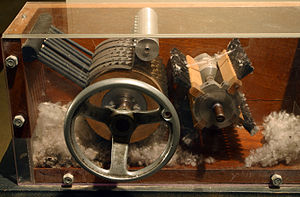
Back محلج القطن Arabic Desmotadora AST Машина за почистване на памука Bulgarian Desmotadora Catalan Egreniermaschine German Kotonseparilo Esperanto Desmotadora Spanish Kotoi makina Basque ماشین پنبهپاککن Persian Puuvillaloukku Finnish

A cotton gin — meaning "cotton engine"[1][2] — is a machine that quickly and easily separates cotton fibers from their seeds, enabling much greater productivity than manual cotton separation.[3] The fibers are then processed into various cotton goods such as calico, while any undamaged cotton is used largely for textiles like clothing. The separated seeds may be used to grow more cotton or to produce cottonseed oil.
Handheld roller gins had been used in the Indian subcontinent since at earliest AD 500 and then in other regions.[4] The Indian worm-gear roller gin, invented sometime around the 16th century,[5] has, according to Lakwete, remained virtually unchanged up to the present time. A modern mechanical cotton gin was created by American inventor Eli Whitney in 1793 and patented in 1794.
Whitney's gin used a combination of a wire screen and small wire hooks to pull the cotton through, while brushes continuously removed the loose cotton lint to prevent jams. It revolutionized the cotton industry in the United States, but also inadvertently led to the growth of slavery in the American South. Whitney's gin made cotton farming more profitable,[citation needed] so plantation owners expanded their plantations and used more slaves to pick cotton. Whitney never invented the machine to harvest cotton: it still had to be picked by hand. The invention has thus been identified as an inadvertent contributing factor to the outbreak of the American Civil War.[6] Modern automated cotton gins use multiple powered cleaning cylinders and saws, and offer far higher productivity than their hand-powered precursors.[7]
- ^ [1]
- ^ [2]
- ^ Roe, Joseph Wickham (1916), English and American Tool Builders, New Haven, Connecticut: Yale University Press, LCCN 16011753. Reprinted by McGraw-Hill, New York and London, 1926 (LCCN 27-24075); and by Lindsay Publications, Inc., Bradley, Illinois, (ISBN 978-0-917914-73-7).
- ^ Cite error: The named reference
LakGinwas invoked but never defined (see the help page). - ^ Habib, Irfan (February 3, 2018). Economic History of Medieval India, 1200-1500. Pearson Education India. ISBN 9788131727911 – via Google Books.
- ^ Cite error: The named reference
WarCausewas invoked but never defined (see the help page). - ^ inventors.about.com; "Background on the Cotton Gin", retrieved October 22, 2010.
© MMXXIII Rich X Search. We shall prevail. All rights reserved. Rich X Search